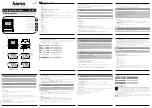
88
89
Precision adjustment is done by means of the timing weights in the case. Place them
on the adjusting-table situated at the middle of the pendulum rod. The heavier the timing
weight, the greater the acceleration of the pendulum, i.e. the faster runs the clock.
By taking away a timing weight, the period of oscillation of the pendulum is lengthened,
i.e. the clock goes slower.
If you need even finer tuned weights for fine adjustment, you will find in our range of
accessories a sorted set of 12 certificated weights
c)
How to correct deviations of 1 - 2 seconds from standard time:
You can correct deviations of 1 - 2 seconds from standard time with the aid of the two
stainless steel weights also enclosed in the case. You neither need to stop the pendulum,
nor the second hand. One of the weights should thus always be located on the adjusting
table.
In case the second hand deviates approx. minus 1 second from standard time, place the
second weight onto the adjusting table as well. As soon as the deviation is recovered,
take the weight off again.
A deviation of approx. plus 1 second shall be corrected by occasionally taking away the
weight permanently located on the adjusting table.
Due to the fact that every place on earth has a different gravitation, a clock that runs +/- 0 sec
in Munich/Germany will gain or loose time if it is located somewhere else.
As an example see the list below:
Place
Gravitation
Fast
Slow
g in cms
-2
in sec./Tday
in sec./day
Bangkok
978,321
106,2
Berlin
981,288
24,4
Budapest
980,852
5,2
Bukarest
980,554
7,9
Göttingen
981,176
19,5
Hamburg
981,375
28,2
Madrid
979,981
33,1
München
980,733
0
0
Nürnberg
980,942
9,2
Rom
980,347
17,0
St. Petersburg
981,925
52,5
Stockholm
981,843
48,8
Stuttgart
980,901
7,4
Tokio
979,805
40,9
How to adjust the accuracy
The clock has been exactly adjusted in our workshop. Transport and variations of the geo -
graphical height can however lead to a change of the period of oscillation of the pendulum.
It will thus in most cases be necessary to adjust your clock new.
Adjust your clock as follows:
a)
Coarse adjustment:
Should the accuracy deviate by more than one second per day it is necessary to adjust
the clock by the adjusting nut.
Please stop the pendulum first. Now put the regulation pin enclosed in the case into the
hole below the counter nut in the pendulum rod to avoid a twisting of the suspension
spring during adjustment.
Loosen the lower nut, the counter nut, and then screw the adjusting nut one line to the
left per second gained per day, i.e. one line to the right per second lost per day. Afterwards
screw the counter nut slightly up again.
After having watched the accuracy a couple of days you may readjust the clock as described
above.
Compensation tube
Regulation nut
Lock nut
Pendulum rod
Hole for regulation pin
b)
Precision adjustment:
For precision adjustment of the clock, i.e. for the correction of small deviations of accuracy,
you don’t need to stop the pendulum
















































